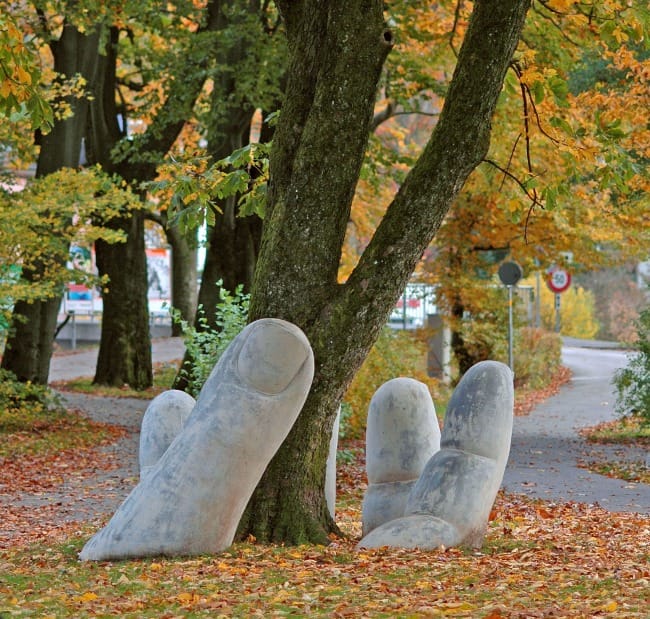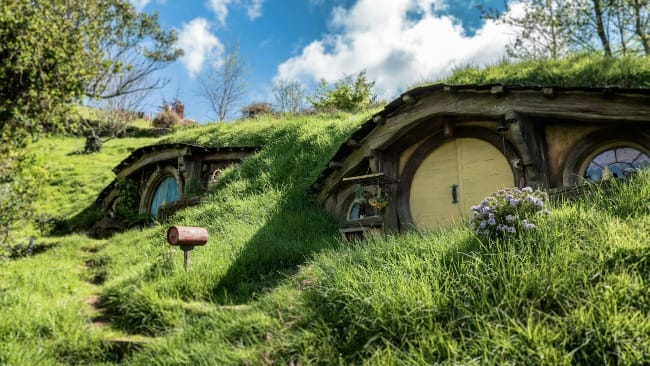In Glarus, Switzerland, within a sliver of park land, between a railroad track and a street, is a sculpture that brings home a simple, but profound point about the role that humans can take in nurturing the natural world around them.

The name of the sculpture is The Hand (dubbed The Caring Hand by many). It is about five feet tall and was cast in concrete by Eva Oertli and Beat Huber in 2004 as part of an exhibition of three-dimensional works in urban space. In their artistic statement, the creators said, "With our sculpture we do not want to set a monument to the gardening profession, but rather point out that we, as a great human race, are responsible for our living space."
The tree within the hand is a European chestnut. It isn't a small tree—it just looks small within the span of the very large hand. It gives off an aura of vulnerability as the large hand of concrete cups it between its fingers. There is an oversized feel about the sculpture as the hand seems bigger and more powerful that the tree within it. I cannot help feeling that the tree is vulnerable within that hand. The fingers surround the tree trunk and it feels as if the tree, growing it seems, out of the palm of the hand, could easily be damaged or even crushed if the hand were to be careless of that tree it holds.
The hand could seemingly damage the tree, but it also seems to provide a potentially shielding fence around its trunk. With fingers that curve inward, it seems to hold it carefully and protectively. It isn't a flat hand merely displaying the tree; it isn't picking it up from above like a specimen to be placed somewhere; it is cupping the tree within its fingers, holding it like you do something that is alive and small. There is a sense of restrained power in those concrete fingers.
There is something about the way the sculpture is incorporated into the setting that is striking. It really does seem to grow out of the ground, rather than appearing to be something that has been imposed on the space from the outside. The hand belongs where it is. In the same way that the tree is rooted in the ground, the hand appears rooted in this space, also. It blends into the creation it is a part of rather than imposing an outside idea that has no connection to the place it inhabits. The sculpture is deeply connected to this place, this tree, this park. Over time, the hand has become naturalized as it has become mossy, less shiny, and more "green." Although concrete, the same material as a parking lot, which is the antithesis of an organic structure, this concrete structure has an organic relationship with its place.
There is something about this sculpture that reminds me of the hobbit holes from J.R.R.Tolkien's writing. Both don't just "happen" to be where they are. There is a connection between the place and the construct. The fact that they both seem to sprout from the earth is partly why this is so, and I think it also has to do with the art adapting itself to a place, rather than expecting the place to completely adapt itself to the art. The Hand sculpture and the hobbit holes are examples of art that accommodate themselves to the natural world; the artist doesn't just flatten everything to make a clean palette for the art; the art honors the place that is already there.

In contrast, when our children were visiting colleges, we visited one that was high on a hilltop, overlooking mountains, water, and a forest that came up the edge of the hill. Strangely, almost the entire campus was paved; all patches of natural growth had been eliminated, replaced by art depicting natural forms in stylized designs. Most puzzling to me was that all around the edge of the campus, blocking any view of the trees, the mountains, or the water far below, was a high, cement wall. Although the spot was in the middle of tremendous natural beauty, you had to work hard to find an outlook between cement structures to see any of it. The campus art was constructed with cement and steel to mimic, but not integrate, the natural beauty that had been there before pavement was laid, living beauty still evident, but only outside the campus walls. It was one of the most beautiful locations of a college campus I have ever seen—and one of the ugliest campuses.
As I look at the hand and the tree, I am struck by the everyday choices we make, whether to nurture this earth we are a part of, to pay no attention to it, or even to exploit it or pave it over. How connected are we to the rest of the creation around us? To hold it as the hand does means attentiveness and care, as someone does when they carry a seedling that needs to be carefully planted and nurtured. We can choose to treasure and value the other life around us as the Hand does and thus be a representative of the creator who made this earth, or we can make choices that attempt to create something completely distinct and separate from the world our creator made.
Reflection Questions: Where do you see examples of art (or other constructs) that honor and fit into the place they inhabit? Is there an action you can take to adapt better into the place you inhabit?
Louise
Click here to leave a COMMENT or SHARE this post
You can contact me directly at info@circlewood.online.
To learn more about The Ecological Disciple's parent organization, visit the Circlewood website.
Don't miss a post! By subscribing to The Ecological Disciple, you will receive new posts directly through email every Monday and Thursday. It's easy and free, and you can unsubscribe at any time.